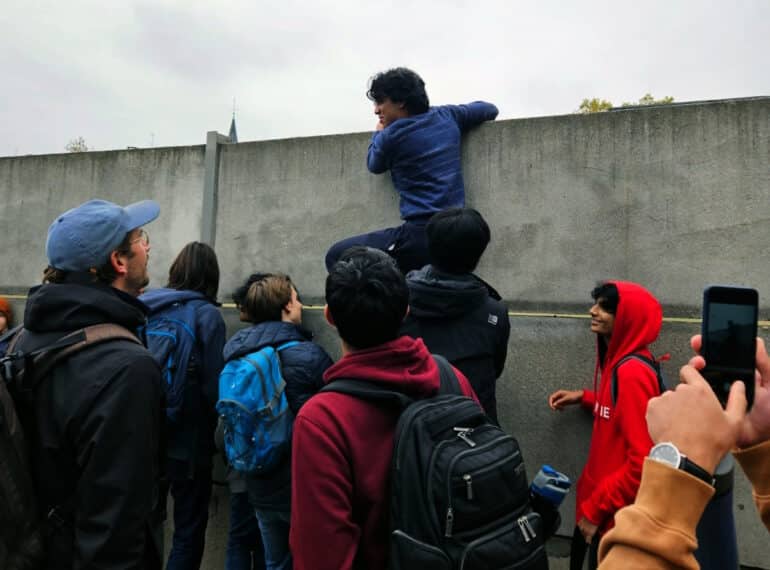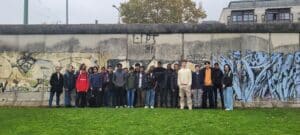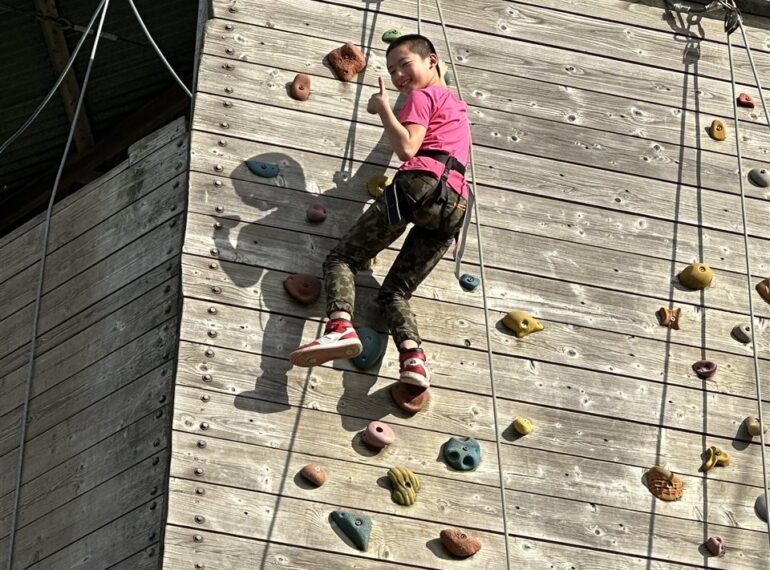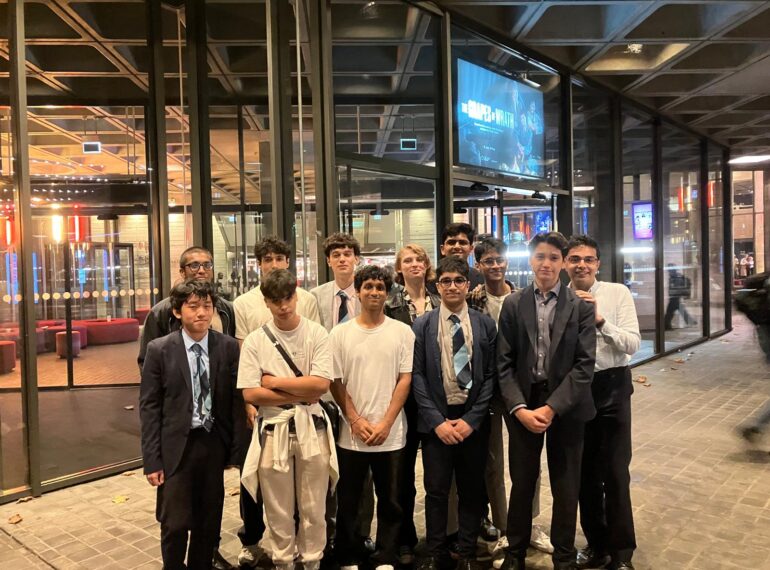
In a QE first, an entire year group headed off to a West End theatre to watch a Shakespeare production.
 The 190 Year 9 boys saw Hollywood A-lister Sigourney Weaver starring in The Tempest at the Theatre Royal, Old Drury Lane.
The 190 Year 9 boys saw Hollywood A-lister Sigourney Weaver starring in The Tempest at the Theatre Royal, Old Drury Lane.
Their visit came shortly after QE’s Year 12 English Literature students took part in a two-day joint event with The Henrietta Barnett School that included a visit to a performance of Richard II at the Bridge Theatre in Bermondsey. QE has a long-standing partnership with the girls’ school, and this event was designed to stretch pupils of the two schools, giving them a taste of what studying Shakespeare at university might be like.
Head of English Robert Hyland said: “Giving students opportunities to experience live theatre remains a central part of our philosophy as an English department. In particular, given the density of language in Shakespeare’s plays, seeing them performed brings them to life in a way which the classroom simply cannot achieve.
“We were very lucky, therefore, to secure tickets to see two sell-out shows in The Tempest and Richard II. Taking just under 200 Year 9 students to see The Tempest will remain a highlight of the academic year. For many, it will have been their first experience of professional theatre, and one which I hope will last for many years after they leave the School. Even afterwards, I could still hear students around the School and in class discussing features of the performance, which hopefully balanced enjoyment with a richer and deeper understanding of the text.
 “Working with our colleagues at Henrietta Barnett allowed us to put on a brilliant day and a half of activities. From a standing start, students became fully acquainted with the characters and themes of the under-appreciated Richard II. It was a treat to see students fully engaging in the dramatic activities, and speaking so knowledgeably about the Bridge Theatre performance.”
“Working with our colleagues at Henrietta Barnett allowed us to put on a brilliant day and a half of activities. From a standing start, students became fully acquainted with the characters and themes of the under-appreciated Richard II. It was a treat to see students fully engaging in the dramatic activities, and speaking so knowledgeably about the Bridge Theatre performance.”
The Year 9 boys students studied The Tempest in the Autumn Term, with the trip therefore forming a conclusion to their studies. Sigourney Weaver, the star of films including Alien and Avatar, played Prospero in a Jamie Lloyd Theatre company production. It was, said Mr Hyland, “a rare opportunity for students to see a world-class actor and production company in real life”. Fourteen staff, drawn from all departments, accompanied the pupils.
Asked to write their own reviews, the Year 9 boys were enthusiastic about their visit. Ridit Bhor praised the “wonderful chemistry” shared by the characters, Miranda and Ferdinand, while others praised the set design, described by Pothan Bobba as “nothing short of spectacular” and by Avi Aggarwal as “hauntingly beautiful”.
 The two-day Sixth Form event centred around the production of Richard II at the Bridge Theatre production, which starred Jonathan Bailey, of Bridgerton and Wicked fame. In addition to seeing the production, the event involved:
The two-day Sixth Form event centred around the production of Richard II at the Bridge Theatre production, which starred Jonathan Bailey, of Bridgerton and Wicked fame. In addition to seeing the production, the event involved:
- An introductory lecture on the play from Dr Diana Hallam, A-level specialist and founder of Literary Lectures, which explored the contextual significance of the play;
- A drama workshop from Mandy Dassa (from QE’s drama partners, RM Drama), exploring the play from a practical perspective;
- Seminars exploring key scenes and speeches from the text, led by Mr Hyland and teachers from the girls’ school;
- A tour of the Globe Theatre combined with a drama workshop on Richard II, led by Royal Shakespeare Company and Globe Theatre actor Chu Omambala.
“We wanted to take students away from their exam specification, and help them understand what it might be like to study Shakespeare at a higher level and through different methods than the A-level allows,” said Mr Hyland. “By picking a text they were unfamiliar with, and allowing them to explore it beyond the normal classroom setting, students were able to develop their skills of interpretation and analysis. And by pairing up with our colleagues at HBS, they could also work with new faces, gaining new ideas and original perspectives.
“With the range of activities on offer, from university-style lectures, seminars, drama, and fieldwork, this partnership event really did give a sense of how exciting and varied studying English at a higher level can be.”

 The 25 boys arrived in the city having studied the Cold War and being close to completing their studies on the Nazi era.
The 25 boys arrived in the city having studied the Cold War and being close to completing their studies on the Nazi era. “There is something powerful about physically seeing the layers of history in a city that has seen incredibly difficult times, and understanding how it is now looking to remember the past while looking ahead to the future.
“There is something powerful about physically seeing the layers of history in a city that has seen incredibly difficult times, and understanding how it is now looking to remember the past while looking ahead to the future.

 The 190 Year 9 boys saw Hollywood A-lister Sigourney Weaver starring in The Tempest at the Theatre Royal, Old Drury Lane.
The 190 Year 9 boys saw Hollywood A-lister Sigourney Weaver starring in The Tempest at the Theatre Royal, Old Drury Lane. “Working with our colleagues at Henrietta Barnett allowed us to put on a brilliant day and a half of activities. From a standing start, students became fully acquainted with the characters and themes of the under-appreciated Richard II. It was a treat to see students fully engaging in the dramatic activities, and speaking so knowledgeably about the Bridge Theatre performance.”
“Working with our colleagues at Henrietta Barnett allowed us to put on a brilliant day and a half of activities. From a standing start, students became fully acquainted with the characters and themes of the under-appreciated Richard II. It was a treat to see students fully engaging in the dramatic activities, and speaking so knowledgeably about the Bridge Theatre performance.” The two-day Sixth Form event centred around the production of Richard II at the Bridge Theatre production, which starred Jonathan Bailey, of Bridgerton and Wicked fame. In addition to seeing the production, the event involved:
The two-day Sixth Form event centred around the production of Richard II at the Bridge Theatre production, which starred Jonathan Bailey, of Bridgerton and Wicked fame. In addition to seeing the production, the event involved:
 His light-hearted attempt to flee – an action which could once have resulted in him being shot – came part-way through the busy trip, during which the group of senior pupils focused on Berlin’s history over the past 100 years or more.
His light-hearted attempt to flee – an action which could once have resulted in him being shot – came part-way through the busy trip, during which the group of senior pupils focused on Berlin’s history over the past 100 years or more. Visiting the Memorial to the Murdered Jews of Europe and the Jewish Museum
Visiting the Memorial to the Murdered Jews of Europe and the Jewish Museum The groups formed from those staying in each room at the hotel had to deliver a presentation in German about a cultural highlight. Pictured is one group delivering theirs on a visit to the Treptower Park, a popular spot with Berliners, which houses the Soviet War Memorial. Each room also prepared a round for the party’s quiz night.
The groups formed from those staying in each room at the hotel had to deliver a presentation in German about a cultural highlight. Pictured is one group delivering theirs on a visit to the Treptower Park, a popular spot with Berliners, which houses the Soviet War Memorial. Each room also prepared a round for the party’s quiz night.

